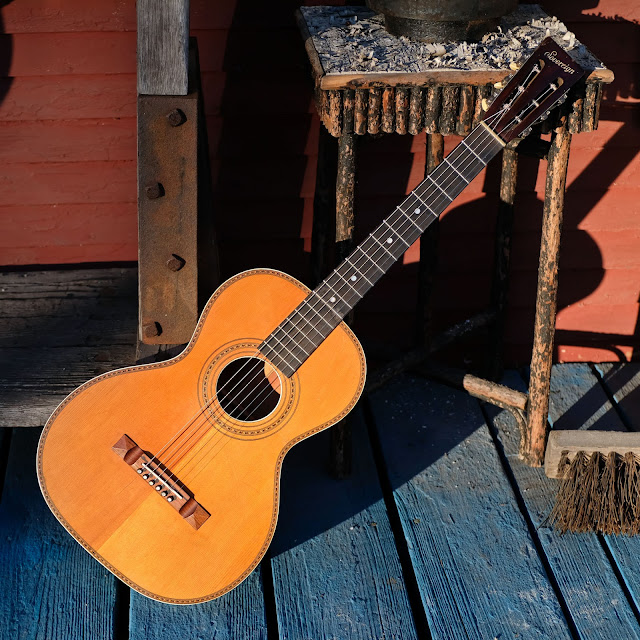1920s Oscar Schmidt-made Sovereign 0-Size Flattop Guitar
This is a gorgeous old Oscar Schmidt (makers of the more famous "Stella" brand until Harmony bought the name in the late '30s) that a customer sent in for repair. It's an 0-size guitar with a 25" scale, ladder-braced spruce top, and mahogany back, sides, and neck. The pyramid-style bridge is rosewood and the fretboard is ebonized maple which gave me some minor challenges due to the fact that the stuff deteriorates over time.
Post-work (which included a neck reset, fret level/dress, bridge-pin and saddle-slot fill and recut, new bone saddle, and setup), it plays beautifully and is happily strung-up with 50w, 38w, 28w, 20w, 15, 11 gauges at standard pitch. Sovereign-branded Schmidts are all a bit nicer-quality than their more pedestrian brands and as a result this guitar has a fuller, warmer, and more "folksy" voice which leans more in the direction of x-braced voicing than your average ladder-braced, honkier-sounding Schmidt product.
The original celluloid nut continues to serve. A rubbed-in line just behind it and before the first fret indicates that this guitar was strung-up Hawaiian-style with raised strings for much of its life.
All the hardware and fittings save the saddle appear to be original, too.
The stained/ebonized fretboard got mealy over time -- a typical thing to happen. I needed to wick glue into all the fret slots to keep them stable before I did my level/dress job. The neck only had a minor amount of warp, too, so not a whole lot of material needed to come off of the frets to get them level.
You can see that there's some mucking-about at the 12th fret. I had to remove the fretboard extension to get at this joint properly as there was some flawed repair-work done in the past. The entire fretboard extension -- because it had separated a bit from the top, anyhow -- was very, very dried-out and prone to chipping-out. I quickly and gingerly reglued it after the neck reset because it has a bunch of hairline dryness cracks running through it both up and down and side to side.
On second thought -- who cares? -- look at that lovely purfling!
After the reset, I had to fill the old saddle slot and move it to where it actually should be. My new slot is compensated properly and drop-in for easy action adjustments via shims or sanding the saddle.
Unfortunately, because of some of the challenges of the funky neck reset (there are in-process repair shots at the end of this post), I had to move the pin slots slightly to the bass side of the bridge. I needed to move them anyway, however, because the saddle had to move back quite a distance.
I'm not happy with the mismatched color of my fill, but it does get the job done without needing to replace the bridge. I'm also not happy with the side-to-side angle of the neck having gone off a hair, but considering the funkiness of the joint, a tiny amount of creep from where I'd set it while it was clamped-up and gluing was not really totally unexpected or the worst thing that could happen.
The original tuners are still going strong.
You can see glue-residue muck at the side of the heel. This was all from the earlier neck reset. I had to peel a couple layers of the stuff off of it and also gobbed-up stuff in the joint as well.
Here's the dovetail joint with the neck removed. Note how the "dovetail" barely has any angle on the walls of the joint. This is why the neck failed in the first place and it's a common problem with many OS builds -- they don't have enough grip as they're essentially tenon joints and so when the glue gave -out, the neck gave-out.
When I took the neck off, the old "repair" had a couple of well-meaning shims installed to try to address this, but the joint wasn't made mechanically stable so it must've drifted pretty fast. There was a big gap at the bottom of the heel when this came in.
Here you can see how straight-cut that is. It's undersized, too -- whether due to original bad profiling or sanding-down prior to the earlier reglue.
My reset involves these two snug-up shims (just sitting in the joint for this pic) which will help to grab the bottom of the dovetail -- which is the most important place to "lock" the neck. Forward movement at the top of the joint can be addressed by shimming-up the front of the joint itself.
All that glassy-looking glue is the original hide glue leavings that will be scraped-off. Here you can see I've prepped the joint for the two over-under neck bolts I added to this joint as well which tighten from inside the soundhole at the neckblock. If I didn't add them, I wouldn't be able to guarantee this joint's stability for any length of time. It was really just bad.



















Comments
Everyone else: Thanks!!